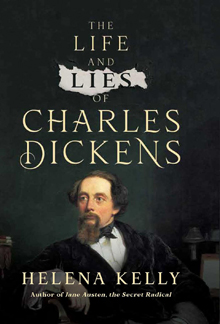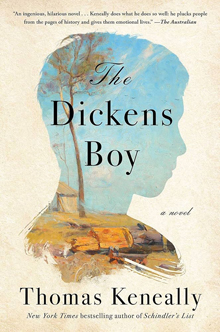The thing is with Dickens is that most of his books are very big. The other things is that most of them are a great read. Fantastic, sometimes convoluted plots; vibrant characters with telling idiosyncrasies; atmospheric settings – all conveyed with a joyous, skilful play with language. Just look at the rhetorical flourishes of this paragraph from the opening of Bleak House:
Fog everywhere. Fog up the river, where it flows among green aits and meadows; fog down the river, where it rolls defiled among the tiers of shipping and the waterside pollutions of a great (and dirty) city. Fog on the Essex marshes, fog on the Kentish heights. Fog creeping into the cabooses of collier-brigs; fog lying out on the yards and hovering in the rigging of great ships; fog drooping on the gunwales of barges and small boats. Fog in the eyes and throats of ancient Greenwich pensioners, wheezing by the firesides of their wards; fog in the stem and bowl of the afternoon pipe of the wrathful skipper, down in his close cabin; fog cruelly pinching the toes and fingers of his shivering little ’prentice boy on deck. Chance people on the bridges peeping over the parapets into a nether sky of fog, with fog all round them, as if they were up in a balloon and hanging in the misty clouds.
Bleak House is a very big book and its very title might seem intimidating, but it is classic Charles Dickens with all those features mentioned above. It’s a wonderful novel, guided by a forceful moral sensibility.
It has often been said that Dickens’ moral sensibility, his alertness to the travails of the poor and the threat of debt are products of his impoverished youth, his father’s imprisonment for debt and his own introduction to the working world as a young boy in a London blacking factory.
Dickens Biographies
 However, much of that well-known history of the great Victorian English novelist has now been cast as constructed myth in a new book, The Lies and Life of Charles Dickens. Helena Kelly published a book on Jane Austen to wide acclaim, but it is daring to look at the historical documents and overturn much of the perceived wisdom about Dickens. This review acknowledges Kelly’s research and the interest of her book , but is concerned that the ideas presented are, when all’s said and done, speculations:
However, much of that well-known history of the great Victorian English novelist has now been cast as constructed myth in a new book, The Lies and Life of Charles Dickens. Helena Kelly published a book on Jane Austen to wide acclaim, but it is daring to look at the historical documents and overturn much of the perceived wisdom about Dickens. This review acknowledges Kelly’s research and the interest of her book , but is concerned that the ideas presented are, when all’s said and done, speculations:
The key words in Kelly’s narrative are “perhaps”, “maybe” and “possibly”, which, supported by her sense of Dickens’s deviousness, allow her to make all sorts of speculations.
To read about Dickens with less speculation and perhaps more careful attention to history and the provable, you could go back to Claire Tomalin’s Charles Dickens, A Life, which was published a dozen years ago. This carefully-researched biography received glowing praise from novelist William Boyd:
Tomalin’s biography – always scrupulous about what we can know, what we can deduce and what is mere speculation
Adapting Dickens
Dickens’ life is fascinating, with his fame, writing, money-spinning lecture tours on one side and his problematic family life on the other. There is, though, no substitute for reading some of the novels, many of which you may know in slightly different forms. At this time of year, A Christmas Carol will come to mind, and many people will know Scrooge even if they haven’t read the book. Oliver Twist is similarly well-known, even if it’s through the musical Oliver! His great autobiographically-based novel David Copperfield is one of his most famous (adapted in the film The Personal History of David Copperfield by Armando Iannucci and starring Dev Patel, and given a updated American twist in Barbara Kingsolver’s recent Demon Copperhead.) I’ve mentioned Bleak House above, but the novel many believe to be his finest is Great Expectations, the retrospective rags to riches and beyond tale of young Pip.
Insights through Fiction
 Another interesting perspective on Dickens comes in Australian novelist Thomas Keneally’s book The Dickens Boy. Dickens sent two of his sons to Australia to make their way in the world, and Keneally imagines the experiences of his youngest, Plorn, who as a sixteen-year-old arrives in Australia to learn sheep farming and grow into a man. He is both conscious of and seeking (vainly) to escape the influence of his famous father, none of whose books he has ever read.
Another interesting perspective on Dickens comes in Australian novelist Thomas Keneally’s book The Dickens Boy. Dickens sent two of his sons to Australia to make their way in the world, and Keneally imagines the experiences of his youngest, Plorn, who as a sixteen-year-old arrives in Australia to learn sheep farming and grow into a man. He is both conscious of and seeking (vainly) to escape the influence of his famous father, none of whose books he has ever read.
It’s an illuminating and thoughtful novel. As one reviewer states:
Keneally has brought off a notable double: a delightful and continuously interesting portrayal of mid-19th century life in the rolling sheep pastures of New South Wales and an acute and persuasive examination of the mystery that Charles Dickens still presents…
The insight into early pioneer Australia is a key feature, as well as its portrayal of father/child relationships and the effect of fame. Another review suggests:
Perhaps the book is at its best when recreating the hard landscape of the Australian Outback, and the everyday lives of the drovers and the Paakantji Aboriginal tribe that live on the Momba sheep station.